The global electric tricycle and microcar market size was valued at $20.5 billion in 2022, and is projected to reach $97.8 billion by 2032, growing at a CAGR of 17.6% from 2023 to 2032.
An electric tricycle is a three-wheeled electric vehicle. It is often equipped with a modest engine and a rechargeable battery, making it an environmentally benign and efficient form of transportation for short distances. Microcars, on the contrary, are small, lightweight vehicles suited for city mobility. These vehicles are often smaller than ordinary cars and are distinguished by their fuel efficiency and maneuverability. Microcars are ideal for navigating densely populated urban areas, providing an alternative and sustainable mode of transportation.
Electric tricycles and microcars are innovative modes of personal transportation designed to provide eco-friendly and efficient alternatives to traditional gas-powered cars. They are becoming increasingly popular due to their environmental benefits and suitability for short-distance commutes and urban mobility.
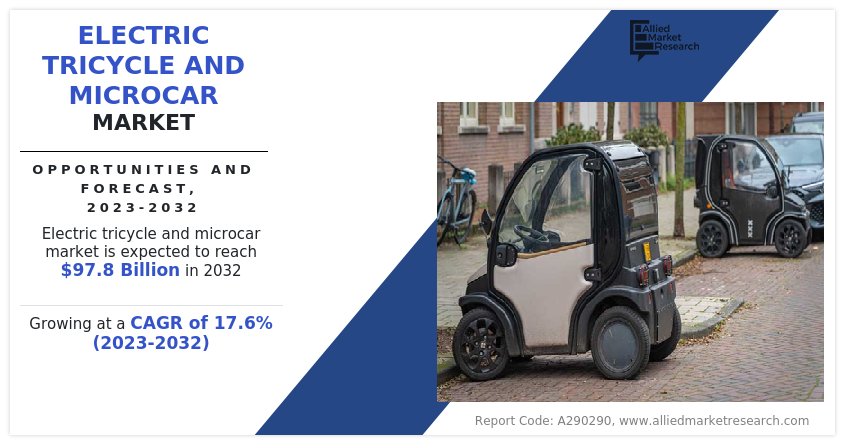
Government-Led Initiatives Propel Growth in the Electric Tricycle and Microcar Market
Government bodies and public institutions worldwide are playing a pivotal role in fostering the electric tricycle and microcars market growth. Their initiatives include the implementation of various subsidies and policies designed to incentivize the adoption of electric and micro electric vehicles. These forward-looking entities are committed toward formulating favorable regulatory frameworks, establishing essential electric charging infrastructure, and providing vital financial support to boost the market growth. The combined effect of these efforts has yielded positive outcomes, including a notable reduction in the prices of micro electric and electric vehicles.
This price decline, driven by government support and the increasing popularity of zero-emission vehicles, has made these eco-friendly transportation options more accessible to consumers. Simultaneously, the ongoing improvements in charging station infrastructure and an intensified focus on expanding the range and capabilities of these vehicles have boosted the global demand for electric tricycles and microcars. Therefore, electric tricycle and microcar market trends developments reflect a collective commitment toward sustainable and efficient urban mobility solutions.
Charging Time Constraints Impeding Electric Tricycle and Microcar Market Growth
The sales of electric tricycle and microcar market faces a significant restraint in the form of charging times. Unlike their internal combustion engine counterparts, which can quickly refuel by simply pouring liquid into a tank, electric vehicles require a more time-consuming process to achieve a full charge. The duration of this charging process varies widely, ranging from as little as twenty minutes for fast-charging stations to more than six hours for regular home charging, depending on the power source, voltage, and the specific type of vehicle.
For urban commuters and short-distance drivers, these charging times may not pose a substantial issue, but for those who rely on their vehicles for longer journeys or who have limited access to fast-charging infrastructure, this can be a considerable drawback. As the electric vehicle market continues to evolve and charging technology improves, reducing these charging times will be a critical factor in expanding the application and practicality of electric tricycles and microcars for a wider range of consumers.
Efficiency and Sustainability in Eco-Friendly Transportation Solutions to Drive Market Growth
The electric tricycle and microcar market presents a promising opportunity driven by their environmentally friendly attributes. These compact electric vehicles typically contribute significantly fewer emissions compared to their conventional counterparts. All-electric tricycles and microcars produce zero tailpipe emissions, while plug-in hybrid electric vehicles (PHEVs) emit no pollutants when operating in electric-only mode. The overall environmental impact of electric vehicles, including their life cycle emissions, is dependent on factors such as electricity generation and regional energy sources.
In regions where renewable energy sources are prominent, the emissions benefits of these vehicles are even more evident. Generally, all-electric vehicles and PHEVs can reduce emissions by up to one-third to half when considering both air pollutants and greenhouse gases, making them a sustainable choice for conscientious consumers. As the global shift toward cleaner energy sources gains momentum, the E-tricycle and microcar market is expected to benefit from the growing demand for eco-friendly transportation solutions.
The key players profiled in electric tricycle and microcar industry report include Mahindra Electric Mobility Limited, Piaggio & C.SpA, Terra Motors, Jiangsu Jinpeng Group Co., Ltd, Jiangsu Huaihai, New Energy Vehicle Co., Ltd. , PT. SGMW Motor Indonesia., MG Motor, Chery, Shandong Shifeng (Group) Co., Ltd., and Luvly. Investment and agreement are common strategies followed by major market players.
For instance, in April 2023, Bajaj Auto introduced its first electric three-wheeler. The product was launched for both the cargo and passenger vehicle segments, but it was made available in a limited number of cities initially as the company wanted to undertake the rollout in a phased manner.
The electric tricycle and microcar market is segmented into Driving Range, Battery Type and Application.
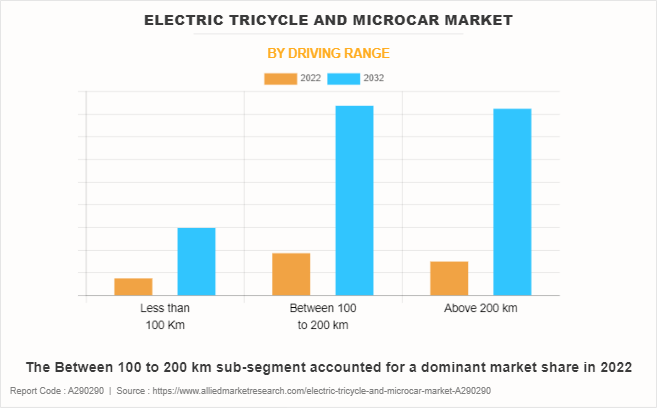
The electric tricycle and microcar industry is segmented on the basis of application, driving range, battery type, and region. By application, the market is divided into passenger transport and cargo delivery. By driving range, the market is classified into less than 100 kms, between 100 to 200 kms, and above 200 kms. By battery type, the market is classified into lithium-ion battery, lead–acid battery, nickel metal hydride battery, and others. By region, the market is analyzed across North America, Europe, Asia-Pacific, and LAMEA.
By driving range, the between 100 to 200 kms sub-segment dominated the global electric tricycles and microcars market share in 2022. The demand for electric tricycles and microcars has been steadily on the rise, and it is a trend that has been gaining momentum over the years. In regions such as India, China, Bangkok, and other. Asian countries, where these vehicles are widely used, their range falls within 100 to 200 kilometers. This specific range is strategically chosen to cater to the typical commuting patterns in these urban areas. Most daily commuters within city limits do not cover distances exceeding 200 kilometers, making tricycles and microcars a practical and efficient choice for their transportation needs.
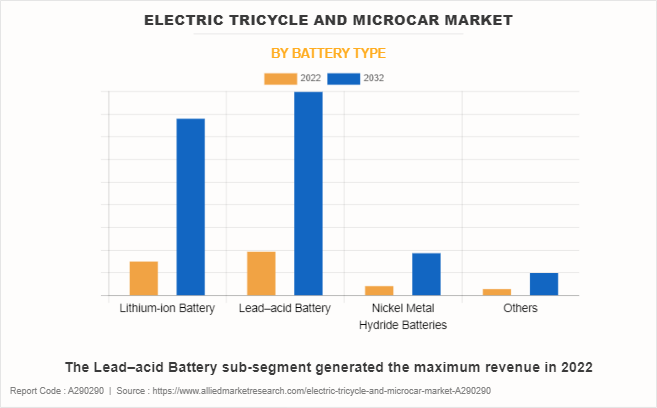
By battery type, the lead–acid battery sub-segment dominated the global electric tricycles and microcars market share in 2022. One of the primary benefits of lead-acid batteries is their low cost. As lead-acid batteries are far less expensive than other types of batteries, they are an appealing alternative for many car owners. Lead-acid batteries come in a number of sizes, making them appropriate for use in a wide range of vehicles.
They can be found in both small, compact automobiles and huge trucks and SUVs. Lead-acid batteries are long-lasting and resistant to a variety of environmental conditions. They are shock-resistant, which means they can withstand the vibration and impacts that occur in a moving vehicle. They are also temperature resistant, making them excellent for usage in both hot and cold areas.
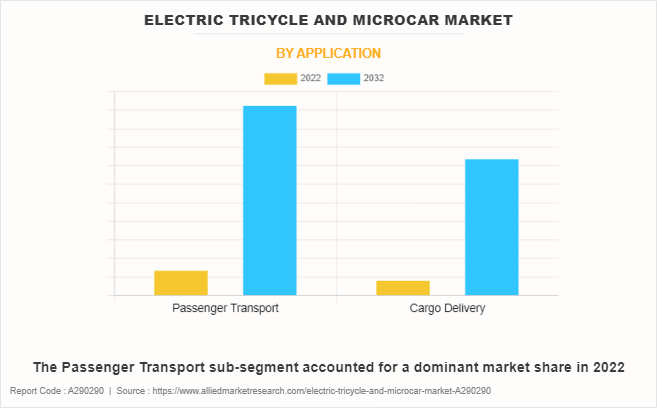
By application, the passenger transport sub-segment dominated the market in 2022. Tricycles and microcars, offer an innovative take on urban mobility. These compact electric vehicles are designed to cater to the needs of urban inhabitants, often featuring small footprints, efficient electric powertrains, and seating capacities tailored to city living. The adoption of tricycles and microcars has been particularly noticeable in Asia-Pacific, where key cities have recognized them as a vital part of the solution to accommodate the rising number of passengers and combat traffic congestion.
As city authorities and businesses seek to reduce their carbon footprint and meet sustainability goals, these microcars are considered as essential in realizing a cleaner, greener future for intra-city transportation. These are predicted to be the major factors affecting the electric tricycles and microcars market size during the forecast period.
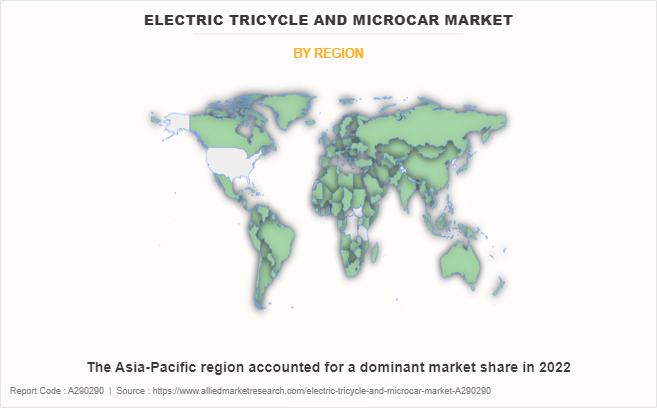
By region, Asia-Pacific dominated the global electric tricycles and microcars market in 2022. Currently, the Asia-Pacific electric three-wheeler industry is witnessing remarkable growth and transformation. These electric three-wheelers, often referred to as e-rickshaws or e-auto-rickshaws, have emerged as a novel solution for last-mile transportation in various countries across the region. Their appeal lies in offering a cleaner, more environmentally friendly, and cost-effective alternative to conventional fossil-fuel-powered three-wheelers.
This has particularly resonated with urban and semi-urban areas characterized by high population density and limited public transportation options. The region's growing commitment toward environmental sustainability and improved air quality is a key driving force behind the rapid expansion of the electric tricycle and microcar market share in Asia-Pacific.
Key Benefits For Stakeholders
- This report provides a quantitative analysis of the market segments, current trends, estimations, and dynamics of the electric tricycle and microcar market analysis from 2022 to 2032 to identify the prevailing market opportunities.
- The market research is offered along with information related to key drivers, restraints, and opportunities.
- Porter's five forces analysis highlights the potency of buyers and suppliers to enable stakeholders make profit-oriented business decisions and strengthen their supplier-buyer network.
- In-depth analysis of the market segmentation assists to determine the prevailing market opportunities.
- Major countries in each region are mapped according to their revenue contribution to the global market.
- Market player positioning facilitates benchmarking and provides a clear understanding of the present position of the market players.
- The report includes the analysis of the regional as well as global market trends, key players, market segments, application areas, and market growth strategies.
Electric Tricycle and Microcar Market Report Highlights
| Aspects | Details |
| Market Size By 2032 | USD 97.8 billion |
| Growth Rate | CAGR of 17.6% |
| Forecast period | 2022 - 2032 |
| Report Pages | 310 |
| By Driving Range |
|
| By Battery Type |
|
| By Application |
|
| By Region |
|
| Key Market Players | Terra Motors, PT. SGMW Motor Indonesia., Piaggio & C. S.p.A., Jiangsu Jinpeng Group Co., Ltd., MG Motor, Mahindra Electric Mobility Limited, Chery, Shandong Shifeng (Group) Co., Ltd., Jiangsu Huaihai New Energy Vehicle Co., Ltd. , Luvly |
Consumers and governments are increasingly interested in more sustainable mobility options, such as electric tricycles and microcars, as environmental awareness and the need to cut greenhouse gas emissions increases.
The major growth strategies adopted by the electric tricycles and microcars market players are investment and agreement.
Asia-Pacific is projected to provide more business opportunities for the global electric tricycles and microcars market in the future.
Mahindra Electric Mobility Limited, Piaggio & C.SpA, Terra Motors, Jiangsu Jinpeng Group Co., Ltd, Jiangsu Huaihai, New Energy Vehicle Co., Ltd., PT. SGMW Motor Indonesia., MG Motor, Chery, Shandong Shifeng (Group) Co., Ltd., and Luvly are the major players in the electric tricycles and microcars market.
The lead-acid battery sub-segment of the battery type acquired the maximum share of the global electric tricycles and microcars market in 2022.
Public transportation, personal vehicle, cargo transport, and others are the major customers in the global electric tricycles and microcars market.
The report provides an extensive qualitative and quantitative analysis of the current trends and future estimations of the global electric tricycles and microcars market from 2022 to 2032 to determine the prevailing opportunities.
Loading Table Of Content...
Loading Research Methodology...



